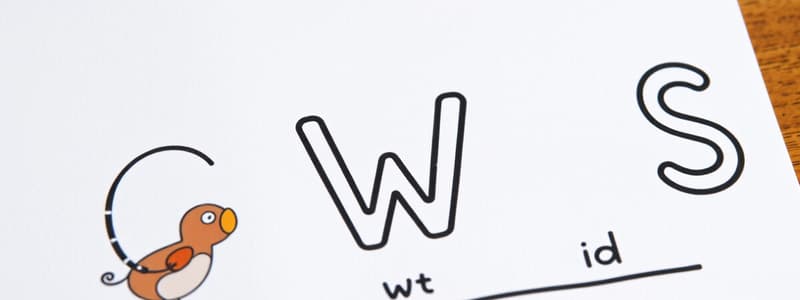Podcast
Questions and Answers
Which sound does 'ou' most commonly represent in the word 'out'?
Which sound does 'ou' most commonly represent in the word 'out'?
- silent
- /oʊ/
- /aʊ/ (correct)
- /ʌ/
Which of the following words contains the 'aw' phonics sound?
Which of the following words contains the 'aw' phonics sound?
- saw (correct)
- rough
- house
- though
What is a key difference between 'ou' and 'aw' phonics?
What is a key difference between 'ou' and 'aw' phonics?
- 'Aw' is predominantly used in words derived from Old English. (correct)
- 'Ou' represents a single, consistent sound.
- 'Aw' can represent multiple sounds.
- 'Ou' is only used in borrowed words.
Which sound does 'aw' most commonly represent?
Which sound does 'aw' most commonly represent?
Which of the following words would contain the /ʌ/ sound represented by 'ou'?
Which of the following words would contain the /ʌ/ sound represented by 'ou'?
Flashcards are hidden until you start studying
Study Notes
Ou and Aw Phonics
Overview
- "Ou" and "aw" are digraphs in English that represent specific vowel sounds.
- They are commonly found in various words and can lead to confusion in pronunciation.
"Ou" Phonics
-
Represents several sounds, most commonly:
- /aʊ/ as in "out" and "about"
- /oʊ/ as in "though" and "dough"
- /ʌ/ as in "rough" and "tough"
- Sometimes silent as in "bought"
-
Common words:
- /aʊ/: out, loud, house
- /oʊ/: though, dough, soul
- /ʌ/: tough, enough, rough
"Aw" Phonics
-
Typically represents the /ɔ:/ sound or /ɔ/ as in "saw" and "draw."
-
Common words:
- saw, law, straw, claw, thaw
Key Differences
- "Ou" can represent multiple sounds, while "aw" generally has a consistent sound.
- "Aw" is predominantly used in words derived from Old English, while "ou" can be found in both native and borrowed words.
Tips for Teaching
- Use visual aids and word cards to illustrate the different sounds.
- Create simple rhymes or songs to reinforce the sounds.
- Encourage reading practice focusing on words with "ou" and "aw" to enhance recognition.
Pronunciation Practice
- Engage in group activities or games that involve identifying and pronouncing words with "ou" and "aw."
- Emphasize the different sounds in context to build understanding.
Overview of Ou and Aw Phonics
- "Ou" and "aw" are English digraphs representing distinct vowel sounds, often causing pronunciation confusion.
"Ou" Phonics
- Represents multiple sounds:
- /aʊ/: Examples include "out," "about," and "loud."
- /oʊ/: Seen in words like "though," "dough," and "soul."
- /ʌ/: Present in "rough," "tough," and "enough."
- Can be silent as in "bought."
- Common words categorized by sound types:
- /aʊ/: out, loud, house.
- /oʊ/: though, dough, soul.
- /ʌ/: tough, enough, rough.
"Aw" Phonics
- Typically represents the /ɔ:/ or /ɔ/ sound, prominent in words like "saw" and "draw."
- Common words include:
- saw, law, straw, claw, thaw.
Key Differences
- "Ou" encompasses various sounds while "aw" maintains a more consistent pronunciation.
- "Aw" primarily appears in words of Old English origin, whereas "ou" can exist in both native and borrowed terms.
Tips for Teaching
- Employ visual aids and word cards to demonstrate different sounds effectively.
- Utilize simple rhymes or songs to reinforce sound recognition.
- Promote reading practice with focus on identifying "ou" and "aw" words to improve familiarity.
Pronunciation Practice
- Engage in group activities or games that highlight word identification and pronunciation for "ou" and "aw."
- Emphasize contextual sound differences to enhance overall comprehension.
Studying That Suits You
Use AI to generate personalized quizzes and flashcards to suit your learning preferences.




